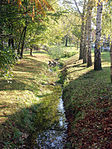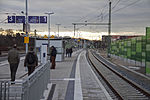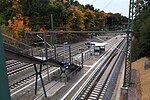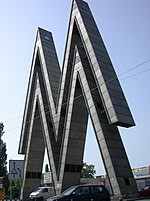Leipzig Anger-Crottendorf railway station
AC with 0 elementsPages with no open date in Infobox stationRailway stations in Leipzig

Leipzig Anger-Crottendorf is a railway station in the city of Leipzig, Germany. The station was located on the Leipzig Hbf–Leipzig-Connewitz railway until its closure in November 2012. As part of City Tunnel network enhancements it was rebuilt thereafter a few meters east at the Leipzig-Engelsdorf–Leipzig-Stötteritz section of the Leipzig Freight Ring and reopened along with Leipzig City Tunnel on 15 December 2013. The station is served by the S-Bahn Mitteldeutschland since then, train services are operated by Deutsche Bahn.
Excerpt from the Wikipedia article Leipzig Anger-Crottendorf railway station (License: CC BY-SA 3.0, Authors, Images).Leipzig Anger-Crottendorf railway station
Zweinaundorfer Straße, Leipzig Anger-Crottendorf (Ost)
Geographical coordinates (GPS) Address Nearby Places Show on map
Geographical coordinates (GPS)
| Latitude | Longitude |
|---|---|
| N 51.3326 ° | E 12.4204 ° |
Address
Blumen Klimsch
Zweinaundorfer Straße 78
04318 Leipzig, Anger-Crottendorf (Ost)
Saxony, Germany
Open on Google Maps










